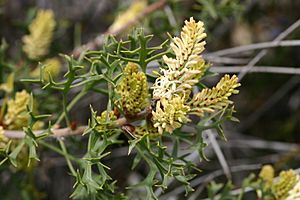Petrophile macrostachya facts for kids
Quick facts for kids Petrophile macrostachya |
|
|---|---|
 |
|
| Petrophile macrostachya, at Cottonwood Crescent Reserve, Perth | |
| Scientific classification | |
| Genus: |
Petrophile
|
| Species: |
macrostachya
|
| Synonyms | |
|
Petrophila macrostachya R.Br. orth. var. |
|
Petrophile macrostachya is a cool flowering plant that belongs to the Proteaceae family. You can only find it growing naturally in the southwestern part of Western Australia. It's a shrub that stands upright and has spiky leaves. Its flowers are yellow or cream-colored and grow in long, round clusters.
Contents
What Does Petrophile Macrostachya Look Like?
Petrophile macrostachya is a neat, upright shrub. It usually grows to be about 0.5 to 1 meter (1.6 to 3.3 feet) tall. Its younger branches are grey and a bit hairy, but they become smooth as they get older.
Leaves and Flowers
The leaves of this plant are quite special. They are deeply divided, almost like feathers, and can be 30 to 80 millimeters (1.2 to 3.1 inches) long. Each leaf has a stalk, called a petiole, which is 20 to 50 millimeters (0.8 to 2 inches) long.
The leaves have between nine and seventeen spiky parts, or lobes, that can be up to 30 millimeters (1.2 inches) long. The flowers are yellow to cream-colored and smooth. They grow in long, cylinder-shaped clusters at the ends of the branches or where leaves meet the stem.
These flower clusters are 20 to 60 millimeters (0.8 to 2.4 inches) long. At the bottom of each cluster, there are overlapping, egg-shaped leaves called bracts. Each flower is about 9 millimeters (0.35 inches) long.
Flowering and Fruit
You can see Petrophile macrostachya in bloom from July to November. After the flowers, the plant produces a type of fruit called a nut. These nuts are joined together in an oval or cylinder-shaped head. This fruit head can grow up to 65 millimeters (2.6 inches) long.
How Petrophile Macrostachya Got Its Name
The plant Petrophile macrostachya was first officially described in 1830. A famous botanist named Robert Brown wrote about it. He included it in his book called Supplementum.
Naming Details
The plant material he used to describe it was collected by Charles Fraser. Fraser found it near the Swan River in 1827. The second part of the plant's name, macrostachya, is a Greek word. It means "long flower spike," which perfectly describes its long flower clusters!
Where Petrophile Macrostachya Grows
Petrophile macrostachya grows in different types of natural areas. You can find it in heathlands, shrublands, and woodlands. It lives in southwestern Western Australia.
Habitat and Regions
Its range stretches from the Kalbarri National Park all the way down to near Gingin. This plant is found in several special natural areas, including the Avon Wheatbelt, Geraldton Sandplains, Jarrah Forest, and Swan Coastal Plain. These areas are part of Australia's biogeographic regions.
Conservation Status
It's good news for Petrophile macrostachya! The Western Australian Government's Department of Parks and Wildlife has classified this plant as "not threatened." This means it is not currently at risk of disappearing.

